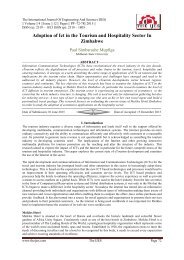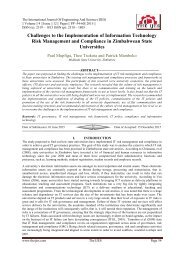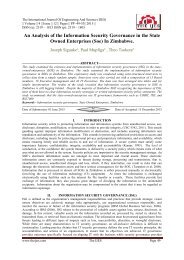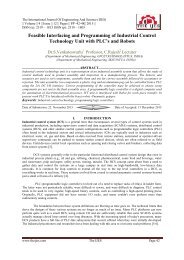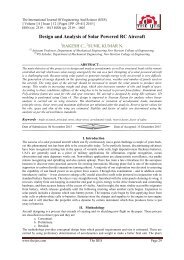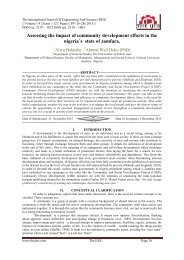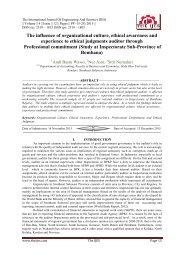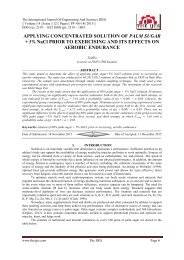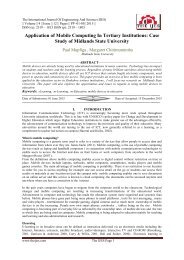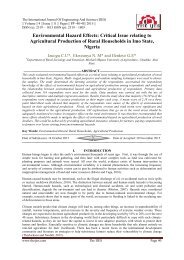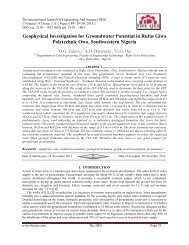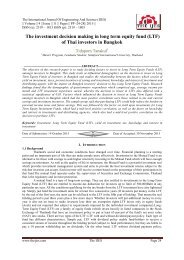o_18sh3v33ugji48t16c41iu887mj.pdf
You also want an ePaper? Increase the reach of your titles
YUMPU automatically turns print PDFs into web optimized ePapers that Google loves.
The International Journal Of Engineering And Science (IJES)<br />
|| Volume || 3 || Issue || 6 || Pages || 01-05 || 2014 ||<br />
ISSN (e): 2319 – 1813 ISSN (p): 2319 – 1805<br />
Evaluation of preliminary phytochemical and antibacterial<br />
activity of Ageratum conyzoides (L) on some clinical bacterial<br />
isolates<br />
O.P. Odeleye* 1 , J. O Oluyege 2 , O. A Aregbesola 3 and P.O Odeleye 4<br />
1- Department of Microbiology, Faculty of Sciences, Ahmadu Bello University, Zaria, Nigeria<br />
2- Department of Microbiology, Faculty of Sciences, Ekiti State University, Ado-Ekiti, Nigeria<br />
3- Department of Microbiology, Faculty of Sciences, Obafemi Awolowo University, Ile-Ife, Nigeria<br />
4- Department of Botany, Faculty of Sciences, Obafemi Awolowo University, Ile-Ife, Nigeria.<br />
----------------------------------------------------------Abstract -----------------------------------------------------<br />
The antimicrobial effects of ethanolic extract of Ageratum conyzoides against Staphylococcus aureus,<br />
Pseudomonas aeruginosa, Escherichia coli, and Shigella dysenteriae was determined using the Agar-well<br />
diffusion technique. The minimum inhibitory concentration (MIC) and minimum bactericidal concentration<br />
(MBC) as well as the phytochemical properties of the extract on the test isolates were also examined using the<br />
standard methods. The phytochemical components of the ethanolic extract of the A. conyzoides include tannin,<br />
alkaloids, steroid, saponin, phenol, flavonoids, triterpenes glycosides and carbohydrate. All the test organisms<br />
were susceptible to ≥50mg/ml of the extract. The MIC and MBC of the ethanolic extract of the A. conyzoides<br />
against S. aureus and E. coli was 120mg/ml, while that of P. aeruginosa and Shigella dysenteriae were<br />
160mg/ml and 200mg/ml of the extract, respectively. The result of this study suggests that the ethanolic extracts<br />
of A. conyzoides could be suitable for the treatment of diseases/infections caused by S. aureus, P. aeruginosa<br />
and E. coli and Shigella dysenteriae.<br />
Keywords: Antimicrobial, Phytochemical, Ethanolic, Susceptible. Minimum inhibitory Concentration, Minimum<br />
bactericidal concentration<br />
---------------------------------------------------------------------------------------------------------------------------------------<br />
Date of Submission: 14 April 2014 Date of Publication: 10 June 2014<br />
---------------------------------------------------------------------------------------------------------------------------------------<br />
I. INTRODUCTION<br />
Plant based antimicrobials represent a vast untapped source for medicines. Plants as gift of nature have<br />
many therapeutic properties combined with much nutritive value which have made their use in chemotherapy as<br />
valuable as the synthetic drugs. The use of medicinal plants all over the world predates the introduction of<br />
antibiotics and other modern drugs into African continent (Akinyemi et al., 2005). Medicinal plants constitute<br />
an effective source of both traditional and modern medicines and about 80% of rural populations depend on it as<br />
their primary health care (Ilori et al., 1996). The use of plant extracts and phyto-products is gaining attention<br />
due to their availability, cost effectiveness, proven nature of specificity, biodegradability, low toxicity and<br />
minimum residual toxicity in the ecosystem (Maji et al., 2005). In recent times, there have been increases in<br />
antibiotic resistant strains of clinically important pathogens which have led to the emergence of new bacterial<br />
strains that are multi-resistant (WHO, 2001; Aibinu et al., 2003; Aibinu et al., 2004). The non-availability and<br />
high cost of new generation antibiotics with limited effective span have resulted in increase in morbidity and<br />
mortality rates (Williams, 2000) which has led to the search for more effective antimicrobial agents among<br />
materials of plant origins with the aim of discovering potentially useful active ingredients that can serve as<br />
source and template for the synthesis of new antimicrobial drugs (Pretorius et al., 2003; Moreillion et al., 2005).<br />
Infectious diseases are caused by some microorganisms and these diseases account for approximately<br />
66.67% of all deaths in tropical countries (Akinnibosun et al., 2009). The increase in the trend of infectious<br />
diseases in the tropics call for a renewed interest in infectious disease in the medical and public health<br />
communities and renewed strategies on treatment and prevention with the development of new antimicrobials<br />
(Iwu et al., 1999). Historically, plants have provided a good source of anti-infective agents with compounds<br />
which are highly effective instrument in the fight against microbial infections. Phytomedicine derived from<br />
plants have shown great promise in the treatment of intractable infectious disease including opportunistic AIDS<br />
infections (Iwu et al., 1999)<br />
In this study, the plant Ageratum conyzoides is studied for its medicinal properties by assay for its<br />
antibacterial properties on selected human pathogenic bacteria of the family enterobacteriaceae namely<br />
www.theijes.com The IJES Page 1
Evaluation of preliminary phytochemical...<br />
Escherichia coli, Shigella dysenteriae, Staphylococcus aureus and as well as Pseudomonas aeruginosa. The<br />
plant is widely utilized in traditional medicine by various cultures and tribe worldwide, although applications<br />
vary by regions. In Nigeria, it is used traditionally in the treatment of different kinds of ailments such as gastrointestinal<br />
pains, diarrhoea, sore throat and skin infection. In central Africa, it is used to treat pneumonia, but the<br />
most common use is to cure wounds and burns (Durodola, 1977). Traditional communities in India used it as a<br />
bacteriocide, antidysenteric and antilithic. In Cameroon and Congo, it is traditionally used to treat fever,<br />
rheumatism, headache and colic (Menut et al., 1993). Therefore, this research was carried out to determine the<br />
phytochemical constituents and antibacterial potential/activity of the ethanolic extracts of Ageratum conyzoides<br />
on some selected Gram-negative bacteria.<br />
II. MATERIALS AND METHODS<br />
Collections and identification of research plant<br />
Fresh leaves, stem and roots of Ageratum conyzoides were collected from Iworoko-Ekiti, Ekiti State,<br />
Nigeria and was authenticated by comparison with herbarium samples at the Department of Plant science and<br />
Forestry, Faculty of Science, University of Ado-Ekiti, Nigeria. The fresh plants were allowed to air dry at room<br />
temperature for five weeks. The dried plants were blended into powder and kept in clean air-tight containers for<br />
further use (Shahidi, 2004).<br />
Extraction procedure of plant materials<br />
Twenty grams (20g) of the powdered plant was suspended in 200ml of Ethanol in 500ml sized conical<br />
flasks. The extracts in the conical flasks were allowed to infuse for two days at room temperature on a rotary<br />
shaker. The ethanolic extracts was obtained by soxhlet extraction (Voskresenky, 1972) and concentrated by<br />
evaporation using a rotary vacuum extractor.<br />
Test organisms<br />
The test bacteria used include Escherichia coli, Shigella dysenteriae, Staphylococcus aureus and<br />
Pseudomonas aeruginosa. Pure culture of these bacteria were obtained and confirmed at the research laboratory<br />
of the Department of Obstetrics and Gynaecology, College of Medicine, University of Lagos. The bacteria were<br />
maintained on nutrient agar slants and stored at 4 o C in a refrigerator until required.<br />
Phytochemical screening of the extracts<br />
The phytochemical screening of the plant extract was carried out according to the method described by<br />
Harborne (1998) and Onwuka (2005) for the purpose of detecting active components of the plant.<br />
Antibacterial bioassay of crude extracts<br />
Agar-well diffusion technique was used for this purpose. A stock solution of 200mg/ml of the ethanolic<br />
extract was prepared using the extracting solvent and was serially diluted to obtain to 100 mg/ml, 50 mg/ml, 25<br />
mg/ml and 5mg/ml (NCCLS, 2000). Each labelled medium plate was uniformly inoculated with a standardized<br />
inoculum (10 5 cfu/ml) of test organism and a sterile cork borer of 5mm diameter was used to bore wells on the<br />
medium into which 0.1ml of the various extract concentration were added (Shahidi, 2004). The inoculated plates<br />
were kept on the bench for 30mins to allow the extracts to diffuse into the agar medium (Atata, 2003). The agar<br />
plates were incubated at 37 o C for 24hours. Antibacterial activities were determined by measuring the diameter<br />
of the zones of inhibition (mm) of the extract against the test organisms after incubation (Junaid et al., 2006).<br />
Minimum Inhibitory Concentration (MIC)<br />
The MIC of the potent extracts was determined according to the macro broth dilution technique.<br />
Standardized suspensions of the test organism was inoculated into a series of sterile tubes of nutrient broth<br />
containing two-fold dilutions of leaf extracts and incubated at 37 ° C for 24 hours. The MICs of the ethanolic<br />
extract were read as the least concentration that inhibited the growth of the test organisms.<br />
Minimum Bactericidal Concentration (MBC)<br />
The MBCs were determined by first selecting tubes that showed no growth during MIC determination;<br />
a loopful from each tube was subcultured onto extract-free agar plates, incubated for further 24 hours at 37°C.<br />
The concentration at which no growth was observed was taken as the MBCs of the extract against the test<br />
organisms.<br />
www.theijes.com The IJES Page 2
Evaluation of preliminary phytochemical...<br />
III. RESULTS<br />
Table 1 shows the phytochemical screening of the ethanolic extracts of Ageratum conyzoides. The result<br />
indicates the presence of tannin, steroids, saponins, alkaloids, phenol, flavonoids and carbohydrate.<br />
Table 1. Phytochemical Constituents of ethanolic extract of Ageratum conyzoides<br />
Phytochemicals<br />
Alkaloids +<br />
Carbohydrates +<br />
Glycosides +<br />
Phenol +<br />
Flavonoids +<br />
Saponins +<br />
Tannins +<br />
Steroid +<br />
Triterpenes +<br />
Bioassay<br />
Key: + = positive - = negative<br />
Table 2 shows the zones of inhibitions (mm) of ethanolic extracts of A. conyzoides on P. aeruginosa,<br />
E.coli, S, aureus and S. dysenteriae at concentrations 5mg/ml, 25mg/ml, 50mg/ml, 100mg/ml and<br />
200mg/ml.<br />
Table 2: Antimicrobial activity of Ethanolic extracts of A. conyzoides.<br />
Test Organism<br />
Staphylococcus aureus<br />
Pseudomonas aeruginosa<br />
Escherichia coli<br />
Shigella dysenteriae<br />
Concentration (mg/ml)<br />
200 100 50 25 5<br />
18.0 13.0 10.0 6.0 0.0<br />
16.0 11.0 9.0 0.0 0.0<br />
10.0 8.0 4.0 0.0 0.0<br />
16.0 14.0 8.0 6.0 0.0<br />
Table 3 shows the minimum inhibitory concentration (MIC) and minimum bactericidal concentration (MBC) of<br />
the test organisms on the ethanolic extract of A. conyzoides. The MIC and MBC were 160mg/ml for P.<br />
aeruginosa, 200mg/ml for Shigella dysenteriae and 120mg/ml for E. coli and Staphylococcus aureus<br />
respectively.<br />
Table 3: The minimum inhibitory concentration (MIC) and minimum bactericidal<br />
concentration (MBC) of the ethanolic extracts of A. conyzoides.<br />
Test Organism MIC (mg/ml) MBC (mg/ml)<br />
Staphylococcus aureus 120 120<br />
Pseudomonas aeruginosa 160 160<br />
Escherichia coli 120 120<br />
Shigella dysenteriae 200 200<br />
www.theijes.com The IJES Page 3
Evaluation of preliminary phytochemical...<br />
IV. DISCUSSION<br />
Phytochemicals act in numerous ways to assist the body in combating diseases and health problems.<br />
The consumption of phytochemicals enhances reduction in the emergence of degenerating diseases (Alan,<br />
1996). In the present study, the phytochemical analysis of the ethanolic extract of A. conyzoides revealed the<br />
presence of alkaloids, saponins, flavonoids, phenol, tannins, steroids and glycosides (Table 1). The result of this<br />
study is in agreement with other previous work (Amadi et al., 2012; Borkataky et al., 2013). The antibacterial<br />
activity of the extract (Table 2) showed that the extract had a broad spectrum of antibacterial activities,<br />
inhibiting P. aeruginosa, E. coli, S. dysenteriae and S. aureus at concentration of ≥50mg/ml. The extract at<br />
25mg/ml was observed to have some activities on S. dysenteriae and S. aureus with zone of inhibition 6.0mm<br />
for both. The antimicrobial activity of A. conyzoides could be due to the abundant presence of phytocompounds<br />
(Phadungkit, et al., 2012) which include alkaloids, flavonoids, tannin, saponins and phenol. Flavonoids<br />
according to Alan, (1996) have shown antibacterial, anti-inflammatory, antiallergic, anti-mutagenic, antiviral,<br />
anti-thrombotic and vasodilatory activity. The presence of the flavonoids may have aided the antibacterial<br />
activity of the plant. Tannins on the other hand have astringent properties and hasten the healing of wounds and<br />
inflamed mucous membrane (Okwu and Okwu, 2004) while studies have shown that saponins exhibit cytotoxic<br />
effect and the growth inhibition against a variety of cell, making them have anti-inflammatory and anticancer<br />
properties. They also show tumour inhibiting activity in animals (Iwu, 1989). The presence of tannins and<br />
saponins in the present study could be attributed to the use of A. conyzoides in treating wounds (Kamboj and<br />
Saluja, 2008). The presence of phenol in the plant extract further explains the antibacterial properties of the<br />
plant as phenols and phenolic compounds have been extensively used in disinfection and remain the standard<br />
with which other bactericides are compared (Okwu, 2001; Okwute and Yakubu, 1998).<br />
The minimum inhibitory concentration (MIC) and minimum bactericidal concentration (MBC) of S. aureus and<br />
E. coli were 120mg/ml, while for P. aeruginosa and S. dysenteriae is 160mg/ml and 200mg/ml respectively.<br />
The result of this study showed that P. aeruginosa E. coli, S. aureus and S. dysenteriae were susceptible to the<br />
ethanolic extract of A. conyzoides which is in support of the study of Akinyemi et al., 2005; Onuoha et al., 2013<br />
and Elimian, et al., (2013).<br />
V. CONCLUSION<br />
The world has entered the era when health is increasingly managed with an eye to cost containment. The<br />
emergence of bacteria stains that are resistance to many conventional antibacterial agents (antibiotics) means<br />
that treatment failures may become more common. This study as shown that Ageratum conyzoides have<br />
potential antibacterial component and activity for the treatment of diarrhoea, wounds, sores and gastrointestinal<br />
tract infections.<br />
References<br />
[1]. Aibinu, I. E., Ohaegbulam, V.C., Adenipekun, E. A., Ogunsola, F.T., Odugbemi, T.O. and Mee, B.J. (2003). Extended-Spectrum<br />
Beta-Lactamase Enzymes in Clinical Isolates of Enterobacter species from Lagos, Nigeria. Journal of Clinical<br />
Microbiology.41(5):2197–2200.<br />
[2]. Aibinu, I., Adenipekun, E. and Odugbemi, T. (2004). Emergence of Quinolone Resistance amongst Escherichia coli strains isolated<br />
from clinical infections in some Lagos State Hospitals in Nigeria. Nigerian Journal of Health and Biomedical Science. 3(2):73–78.<br />
[3]. Akinyemi, K. O., Oladapo, O., Okwara, C. E., Ibe, C. C. and Fasure, K. A. (2005). ―Screening of crude extracts of six medicinal<br />
plants used in South-West Nigerian unorthodox medicine for anti-methicillin resistant Staphylococcus aureus activity,‖ BMC<br />
Complementary and Alternative Medicine, vol. 5, article 6.<br />
[4]. Akinyemi, K.O., Oladapo, O., Okwara, C.E., Ibe, C.C. and Fasure, K.A. (2005). Screening of crude extracts of six medicinal plants<br />
used in southwest Nigerian unorthodox medicine for anti-methicillin resistant Staphylococcus aureus activity. BMC Complementary<br />
and Alternative Medicine. 5:6.<br />
[5]. Alan, L. M. (1996). Antioxidant flavonoids: structure, function and clinical usage. Alternative Medicine Review 1(2): 103-111<br />
[6]. Amadi, B.A., Duru, M.K.C. and Agomuo, E.N. (2012). Chemical profiles of leaf, stem, root and flower of Ageratum conyzoides.<br />
Asian Journal of Plant Science and Research 2(4): 428-432<br />
[7]. Atata, R,. Sani, A. and Ajewole, S.M. (2003). Effect of stem back extracts of Enantia chloranta on some clinical<br />
isolates. Biokemistri. 15(2):84–92.<br />
[8]. Borkataky, M., Kakoty, B.B. and Salkia, L.R. (2013). Antimicrobial activity and phytochemical screening of some common<br />
asteraceae family. International Journal of Pharmaceutical Sciences Review and Research 23(1): 116-120.<br />
[9]. Durodola, J.J. (1977). Antibacterial property of crude extracts from herbal wound healing remedy—Ageratum conyzoides. Plant<br />
and Medicine. 32:388–390.<br />
[10]. Elimian, K.O., Daniel, E.O., Adesanmi, E.A. and Osazee, J.O. (2013). Comparative analysis of Ageratum conyzoides L. and<br />
Ocimum gatissimum extracts on some clinical bacterial isolates. Asian Journal of Plant Science and Research 3(5): 65-69.<br />
[11]. Harborne, J.B. (1998). Phytochemical Methods: A Guide to Modern Techniques of Plant Analysis. 3rd Edn., chapman and<br />
Hall:London. pp.302.<br />
[12]. Ilori, M.O., Shiteolu, A., Omonigbehin, E.A. and Adeneye, A.A. (1996). Anti-diarrheal activities of Ocimum gratissimum. Journal<br />
of Diarrhoea and Disease Fies 14: 54-58.<br />
[13]. Iwu, M.W., Duncan, A.R. and Okunji, C.O. (1999). New antimicrobials of plant origin. In: Perspectives on new crops and new<br />
uses. J. Janick (ed.), ASHS Press, Alexandria, VA. p. 457–462.<br />
www.theijes.com The IJES Page 4
Evaluation of preliminary phytochemical...<br />
[14]. Junaid, S.A., Olabode, A.O., Onwuliri, F.C., Okwori, A.E.J. and Agina, S.E. (2006). The antimicrobial properties of Ocimum<br />
gratissimum extracts on some selected bacterial gastrointestinal isolates. African Journal of Biotechnology. 5 (22): 2315-2321.<br />
[15]. Kamboj, A. and Saluja, A. K. (2008). Ageratum conyzoides L.: A review on its phytochemical and pharmacological profile.<br />
International Journal of Green Pharmacy. 2:59-68.<br />
[16]. Maji, D., Roy, R.U. and Das, S. (2005). Prevention of Type 2 Diabetes in the Prediabetic Population. Journal Indian Medical<br />
Association; 103(11):609-11.<br />
[17]. Menut, C., Sharma, S. and Luthra, C. (1993). Aromatic plants of tropical central Africa, Part<br />
X—Chemical composition of essential oils of Ageratum houstonianum Mill. and Ageratum conyzoides L. from Cameroon. Flavour<br />
and Fragrance Journal. 8(1):1–4.<br />
[18]. Moreillion, P., Que, Y.A. and Glauser, M.P. (2005). Staphylococcus aureus (Including Staphyloccal Toxic shock) In: ‗Principles<br />
and Practice of Infectious diseases‘. Mandell GL, Bennett JE, Dolin R, editors. 6th ed. Vol. 2. Pennyslyvania: Published by<br />
Churchill livingstone; pp. 2333–2339.<br />
[19]. National committee for clinical laboratory standards (2000). Methods for dilution, antimicrobial susceptibility tests for bacteria that<br />
grow aerobically. 5th ed. p. 30.<br />
[20]. Okwu, D. E, and Okwu, M.E., (2004). Chemical composition of Spondia mombin plants. Journal of Sustainance Agriculature and<br />
Environment. 6: 140-147.<br />
[21]. Okwu, D.E., (2001). Improving the nutrition value of cassava tapioca meal with local spicies. Nutracentical, Functional and<br />
medicinal food 3: 4351.<br />
[22]. Okwute, S.K. and Yakubu, M.O. (1998). Zuma. Journal of Pure and Applied Science.1: 21-24.<br />
[23]. Onuoha, O.G., Ayo, J.A., Osuagwu, V. and Iruolaje, F.O. (2013). Investigation of the anti-bacterial activity of Ageratum<br />
conyzoides extract on microorganisms isolated from septic wound. Topclass Journal of Herbal Medicine 2(8): 182-188.<br />
[24]. Onwuka, G.I. (2005). Food analysis and instrumentation (Theory and Practice), 1 st edition. Naphtali prints, Surulere, Lagos, pp.50-<br />
58<br />
[25]. Pretorius, J.C., Magama, S. and Zietsman, P.C. (2003). Growth inhibition of plant pathogenic bacteria and fungi by extracts from<br />
selected South African plant species. South African Journal of Botany, 20:188-192.<br />
[26]. Shahidi Bonjar, G.H. (2004). Evaluation of Antimicrobial Properties of Iranian Medicinal plants against some pathogenic<br />
organisms. Asian Journal of Sciences. 3(1):82-86.<br />
[27]. Williams, R. (2000). Antimicrobial resistance- a global threat. Essential drug Monitor. 1:28-29.<br />
[28]. World Health Organization (2001). Traditional medicine. Facts sheet no 134. Revised May, 2003. Available on<br />
http//www.who.int/media centre fact sheet/fs/134.<br />
www.theijes.com The IJES Page 5



